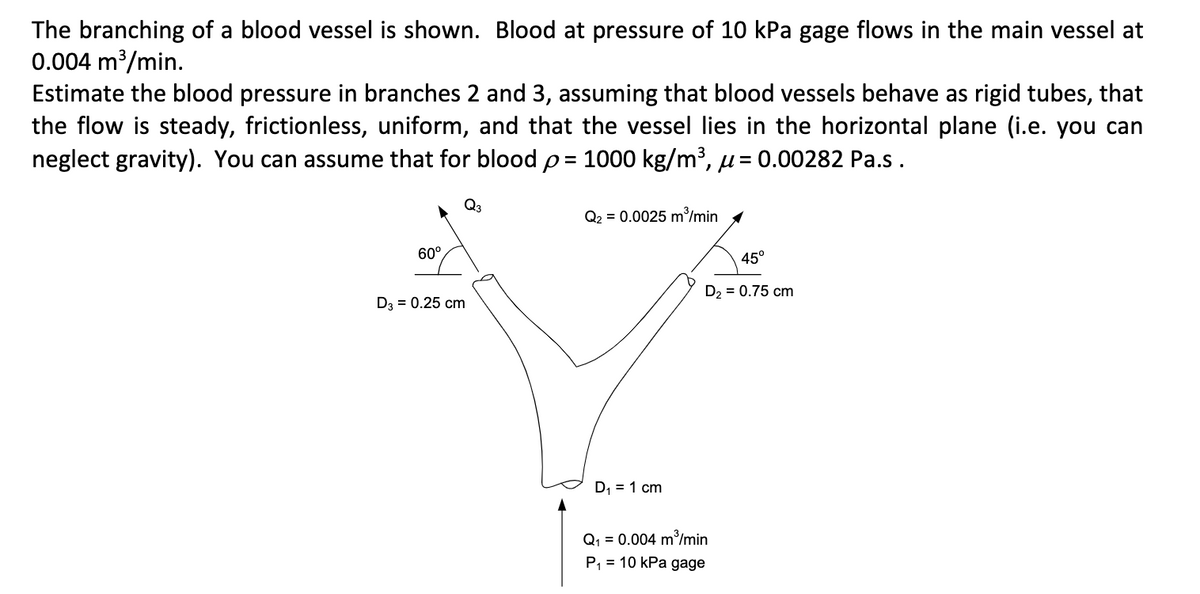The branching of a blood vessel is shown. Blood at pressure of 10 kPa gage flows in the main vessel at 0.004 m³/min. Estimate the blood pressure in branches 2 and 3, assuming that blood vessels behave as rigid tubes, that the flow is steady, frictionless, uniform, and that the vessel lies in the horizontal plane (i.e. you can neglect gravity). You can assume that for blood p = 1000 kg/m³, µ= 0.00282 Pa.s. Q3 Q2 = 0.0025 m³/min 60° 45° D2 = 0.75 cm D3 = 0.25 cm D, = 1 cm Q1 = 0.004 m³/Imin P, = 10 kPa gage
The branching of a blood vessel is shown. Blood at pressure of 10 kPa gage flows in the main vessel at 0.004 m³/min. Estimate the blood pressure in branches 2 and 3, assuming that blood vessels behave as rigid tubes, that the flow is steady, frictionless, uniform, and that the vessel lies in the horizontal plane (i.e. you can neglect gravity). You can assume that for blood p = 1000 kg/m³, µ= 0.00282 Pa.s. Q3 Q2 = 0.0025 m³/min 60° 45° D2 = 0.75 cm D3 = 0.25 cm D, = 1 cm Q1 = 0.004 m³/Imin P, = 10 kPa gage
Principles of Heat Transfer (Activate Learning with these NEW titles from Engineering!)
8th Edition
ISBN:9781305387102
Author:Kreith, Frank; Manglik, Raj M.
Publisher:Kreith, Frank; Manglik, Raj M.
Chapter6: Forced Convection Over Exterior Surfaces
Section: Chapter Questions
Problem 6.34P
Related questions
Question

Transcribed Image Text:The branching of a blood vessel is shown. Blood at pressure of 10 kPa gage flows in the main vessel at
0.004 m3/min.
Estimate the blood pressure in branches 2 and 3, assuming that blood vessels behave as rigid tubes, that
the flow is steady, frictionless, uniform, and that the vessel lies in the horizontal plane (i.e. you can
neglect gravity). You can assume that for blood p= 1000 kg/m³, µ= 0.00282 Pa.s.
Q3
Q2 = 0.0025 m³/min
60°.
45°
D2 = 0.75 cm
D3 = 0.25 cm
D, = 1 cm
Q1 = 0.004 m/min
P, = 10 kPa gage
Expert Solution
This question has been solved!
Explore an expertly crafted, step-by-step solution for a thorough understanding of key concepts.
This is a popular solution!
Trending now
This is a popular solution!
Step by step
Solved in 4 steps with 4 images

Knowledge Booster
Learn more about
Need a deep-dive on the concept behind this application? Look no further. Learn more about this topic, mechanical-engineering and related others by exploring similar questions and additional content below.Recommended textbooks for you

Principles of Heat Transfer (Activate Learning wi…
Mechanical Engineering
ISBN:
9781305387102
Author:
Kreith, Frank; Manglik, Raj M.
Publisher:
Cengage Learning

Principles of Heat Transfer (Activate Learning wi…
Mechanical Engineering
ISBN:
9781305387102
Author:
Kreith, Frank; Manglik, Raj M.
Publisher:
Cengage Learning